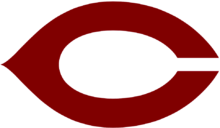Chicago Maroons football
The Chicago Maroons football represents the University of Chicago in college football. The Maroons play in NCAA Division III as an independent team. From 1892 to 1939, the Maroons were a major college football power. The University of Chicago was a founding member of the Big Ten Conference and the Maroons were coached by Amos Alonzo Stagg, one of the game's pioneers, for 41 seasons. In 1935, halfback Jay Berwanger became the first recipient of the Downtown Athletic Club Trophy, later known as the Heisman Trophy. Nonetheless, in the late 1930s, university president Robert Maynard Hutchins decided that big-time college football and the university's commitment to academics was not a good fit.[2] The University of Chicago abolished its football program in 1939 and withdrew from the Big Ten in 1946. Football returned to the University of Chicago in 1963 in the form of a club team, which was upgraded to varsity status in 1969. The Maroons began competing in Division III in 1973.
Division history
| Year |
Division |
| 1937–1939 |
NCAA University Division (Major College) |
| 1940–1962 |
No team |
| 1963–1968 |
Club team |
| 1969–1972 |
No Classification |
| 1973–present |
NCAA Division III |
Conferences
Records
- Most Wins: 16 (1899)
- Most Losses: 10 (1991)
- Most Ties: 3 (1924)
Championships
National championships
- 1905 (National Championship Foundation Poll)
- 1913 (Parke H. Davis) (2)
University Athletic Association championships
- 1998
- 2000 (2)
- 2005 (3)
- 2010 (4)
- 2014 (5)
Big Ten Conference championships
- 1899
- 1905 (2)
- 1907 (3)
- 1908 (4)
- 1913 (5)
- 1922 (6)
- 1924 (7)
All-Time Record Against Current Big Ten Members[4]
Note: Michigan State, Penn State, Nebraska, Maryland, and Rutgers were not members of the Big Ten when Chicago was a member.
Notable personnel
College Football Hall of Fame
| Name | Position | Years | Inducted | Notes |
|---|
| Jay Berwanger |
Halfback | 1933–1935 | 1954 | First recipient of the Heisman Trophy |
| Hugo Bezdek |
Fullback | 1905 | 1954 | Inducted for his career as a coach at Oregon, Arkansas, and Penn State |
| Fritz Crisler |
End | 1919–1921 | 1954 | Inducted for his career as a coach at Minnesota, Princeton, and Michigan |
| Paul Des Jardien |
Center | 1912–1914 | 1955 | All-American in 1913 and 1914 |
| Walter Eckersall |
Quarterback | 1903–1906 | 1951 | Leader of the 1905 national championship team |
| Clarence Herschberger |
Fullback | 1895–1898 | 1970 | First western player selected as a first-team All-American |
| Tiny Maxwell |
Guard | 1902, 1904–1905 | 1974 | All-American for 1905 national championship team |
| Clark Shaughnessy |
Coach | 1933–1939 | 1968 | College football coach for 50 years |
| Amos Alonzo Stagg |
Coach | 1892–1932 | 1951 | "The Grand Old Man of the Midway" |
| Walter Steffen |
Quarterback | 1906–1908 | 1969 | Scored 156 points for teams that went 13-2-1; First-team All-American, 1908 |
| Andy "Polyphemus" Wyant |
Guard, Center | 1892–1894 | 1962 | Played 8 varsity seasons of college football for Bucknell and Chicago |
Others
- Walter S. Kennedy, quarterback for Stagg's 1898-1899 teams
- Walter E. Marks, fullback and halfback, 1924–1926; leader of Chicago's last Big Ten championship team
- Nelson Norgren, played football under Stagg, coached Chicago basketball team, 1921–1942, 1944–1957
- Laurens Shull, All-American, killed in action during World War I
- Frederick A. Speik, end, All-American, 1904
- Herman Stegeman, played for 1913 national championship; later coached football, baseball, basketball and track at Georgia
- John Webster Thomas, fullback, All-American 1922, played for Stagg 1921-1923
- Mysterious Walker, played for Stagg, 1904–1906; coached college teams, 1907–1940
See also
References
External links
|
|---|
|
| Venues |
- Marshall Field (1893–1912)
- Old Stagg Field (1913–1939)
- Stagg Field (?–present)
|
|---|
|
| Bowls & rivalries | |
|---|
|
| Culture & lore | |
|---|
|
| People | |
|---|
|
| Seasons | |
|---|
|
National championship seasons in bold |


